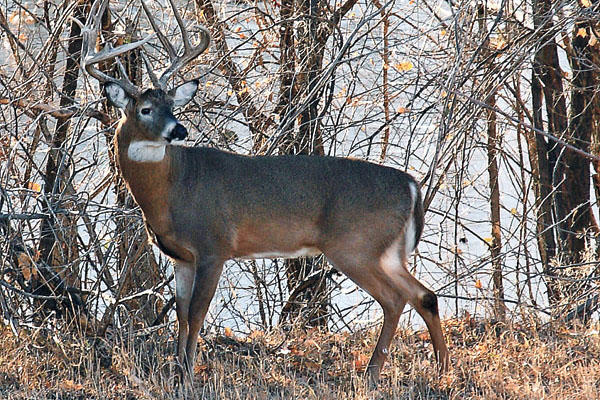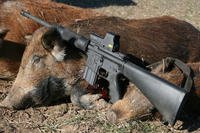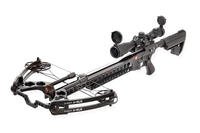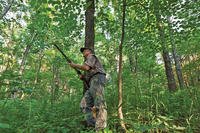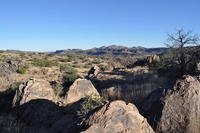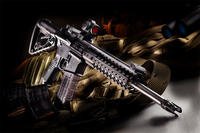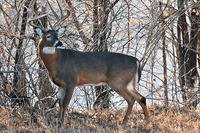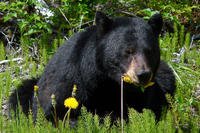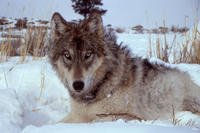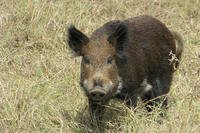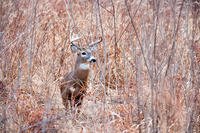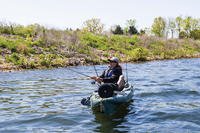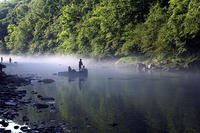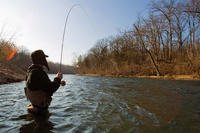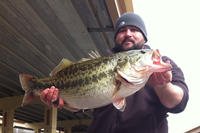In a world where human nature is constantly seeking out the nice and easy, efficient and practical, comfortable and neat and serene, bowhunting is an anomaly. We love bowhunting because it's so hard. We like to think we're tough to be able to make it as a bowhunter. But no matter what a tough guy you might be, bowhunting can leave you in whimpering ruin. You can practice and prepare and work out and set up for months, only to see it all fall apart in the moment of truth due to fractions of an inch, a split second, a small degree of angle.
And that's just on a normal day of bowhunting. Sometimes it gets really challenging. The best bowhunters are those who meet those special challenges and rack up scores in the worst of situations. Here are a few of those worst-case scenarios and what I've learned about them.
The Players
Xtreme Weather
In the pitch-black predawn, with gusty wind and foreboding thunder rumbling in the distance, I made my way across the cropped beanfield toward my stand. By the time I got there I was being pelted by rain; by shooting light the water was finding its way through my rain suit. And then the lightning arrived. But it was November 3, peak of the rut, and danged if I was going to pass a chance to get in a brief hunt before work.
In the next hour I became soaked and shivering, my tree rocked in the wind, and I even lowered my aluminum-risered lightning rod - I mean bow - to the ground for a few minutes when the bolts were really close.
I wondered if I was the only bowhunter in Minnesota out in this crap today. Then I turned my head to the right and said "sombrero."
Sombrero is a term I use for my favorite kind of bucks - those with antlers so wide and massive that they remind me of those ridiculously large Mexican hats.
I had a sombrero coming at me fast. I grabbed the bow and got to full draw just as he passed me on a trot; I let loose and smacked him hard. Awhile later I wrapped my wet hands around wet antlers - the biggest I'd ever seen in the woods up til then - and couldn't have cared less that I was soaked to the bone and cold.
In the years since, I've noticed I've had some of my best success in nasty weather, the kind most bowhunters don't even consider hunting in. Four of my six best bucks have been taken in or around rain or snow storms. At a camp in Mississippi once I went hunting in the rain and the dozen or so other guys took the day off. In the middle of it, I was treated to one of my most awesome encounters in bowhunting - a group of seven nice bucks in a row parading past my stand! I'm sure the other guys in camp have wonderful memories of that day too, of, well, whatever they were watching on TV.
There's not a lot of finesse involved in conquering this obstacle. Like many things in life, it mainly depends on determination. Get good raingear, be extra careful, but most of all, just plain get out there and hunt!
Xtreme Cold
I love bowhunting the late season, and the colder it is, the better I like it, because I've found it makes deer move, and I enjoy the challenge of battling the elements. Cold works against the bowhunter in several ways. It hurts the performance of your gear and sometimes just plain makes it fail. It makes your muscles less useful - you won't shoot nearly as accurately. Once I was so cold I couldn't get my bow drawn. Finally, when you get too cold, you just gotta go. And nothing is going to hurt your chances of success more than going home.
Being a Minnesota boy, I have decades of experience battling the cold by just plain toughing it out. But the frostbite I've experienced because of it has softened me up some. Now, I fight the cold by throwing a ton of gear at it. There's some really good equipment now that eliminates any excuse for shrinking from the cold.
In dressing, I'm going to be emphasizing efficiency, protecting the most important places and bulking up my extremities so I can go with the minimum on my torso to prevent clothing from interfering with my bowstring. So, I start with silk underwear because it's so comfortable and I need protection from the next layer, wool underwear. Then I'll have one or two layers of insulated pants, a high-tech sweater, and a bulky vest - the vest is essential to aid shooting freedom.
My parka is always windproof and has a hood, maximizing efficiency again. It is lighter weight than you'd think, though, because I learned long ago the folly of hiking in dressed like the Pillsbury Doughboy and getting wet with sweat. Instead, I dress for the hike and pack in a Heater Body Suit. I will not hunt in the very cold without one of those suits.
To this I add a generous dose of chemical handwarmers, electric garments like socks, gloves and vest, and a neck warmer. I can tell you with this arsenal, hunting last January 15 in Illinois in a negative-22-degree wind chill, I was cozy all morning.
Xtremely Long Shots
While I'm not really going to advocate extremely long shots, most bowhunters could considerably extend their effective shooting range with a dedicated approach.
Let's say your effective shooting range - the range in which you can keep nine out of 10 arrows in the vitals - is 25 yards. What if you could extend your "dead zone" to 35?
For one thing, you'd be essentially doubling the effective hunting area around your stand. With a range of 25 yards, you're covering an area of 490 square yards. (The formula for figuring the area of a circle is pi(r2) or 3.14 x the squared radius of the circle.)
At 35 yards, you'd be covering 961 square yards - just shy of twice the area! Plus, any experienced bowhunter knows that it's a lot easier to get a shot off undetected at that 25 to 35-yard range compared to shots at wired bucks standing 25 yards or less from your stand.
Extending your range - improving your shooting accuracy - is a formula based on several factors: improving your gear, your technique, and your mental approach. A book could be written on each of those factors, but I'll give you the list of essentials and you can take it from there.
* Get a laser rangefinder (don't dream of shooting longer ranges without one.)
* Maximize arrow velocity and flatten arrow trajectory by working out so you can draw a heavier bow, make that bow a high-performance rig, shoot your longest comfortable draw length and further maximize draw length with a mechanical release with the trigger close to its jaws.
* Don't try to flatten arrow trajectory by shooting super-light arrows. You'll need maximum arrow energy at longer ranges and will get it from heavier arrows.
* Shoot a good mechanical broadhead, which contrary to popular belief, will outperform most fixed-blade heads penetration-wise and always give you more accuracy.
* Use a smaller peep and finer pins.
* Tune and stabilize the heck out of your bow.
* Hone your shooting techniques, including proper aiming, trigger squeeze, back tension and follow-through. If you're serious about this, consult a qualified coach.
Xtremely Quick Shots
We all hope and pray that when the buck we want arrives, he'll present a nice broadside angle and plenty of time for us to compose ourselves, aim, and deliver the arrow.
But this is bowhunting, remember? Big bucks make a living by being unaccommodating. They are more likely to flash through a shooting lane or gallop down a trail, hardly giving us time to grab our bow.
Bowhunters lose thousands of opportunities this way every fall, but it doesn't have to be. The secret is the same for many bowhunting challenges: Be prepared for it.
Most of us shoot hundreds or thousands of arrows through the summer. How many of us actually prepare for a fleeting shot and practice shooting quickly? I don't know any, and I never did before sobering up a few years ago.
Remembering a lost opportunity from the previous fall, I visualized a buck stealing silently up from behind me and starting to pass beyond shooting range. I grabbed up the bow, drew quickly, aimed hastily and let fly. It wasn't good. It felt awkward, I knew I made too much noise and motion, and I missed the vitals. But after just a few shots I improved dramatically, just because I had gained a little experience through practice.
A few months later I found myself in the thunderstorm mentioned earlier. Because it was dark and raining and wet, the buck was on me without warning. It was the quickest shot I ever tried, and he was moving, but I made it.
The quick shot. Practice it. In this exercise, practice staying calm, moving smoothly, using your instincts, and quickly drawing, acquiring the target and getting the arrow off. Practice this from an elevated position and on moving targets as well.
Xtreme Adrenaline Situations
It's kinda funny, really. We bowhunt for excitement, mainly, but it's that very excitement that can wreck it for us. And it's most apt to happen when we really want to succeed the most. We're talking buck fever.
All bowhunters experience it to one degree or another, and differently at different times. In the milder cases, we might be able to pull off the shot with no outward signs to indicate the fact that our heart is trying to hammer through our ribcage. Sometimes we shake, which can really hurt our shooting. Often we just plain make a bad shot. Or we might, after taking 10,000 carefully practiced shots on the range all summer, yank the string back and let fly without aiming whatsoever in total panic mode. We might not be able to draw the bow. We might drop it. The worst version of this affliction is a full-blown case of target panic, in which we could hardly hit a bale of hay at three feet and wonder if we are going insane.
Whatever the degree, it all results from the emotional subconscious mind generating a type of fear that is very difficult to control with the conscious mind.
There are two ways that I know of to win in this battle of the minds - conditioning, and channeling.
By conditioning I mean getting used to shooting in pressure situations. Visualizing can work well. Visualize as best you can the buck of a lifetime approaching. If you're good at it, it will be close to the real thing; your heart rate will actually increase. If that doesn't work, try something more practical. One thing that works for me is setting my target in front of my truck and letting arrows fly from further and further away. Trust me, a guy's subconscious does not like that at all!
In a real situation, what I call "channeling" can work great. Take that subconscious fear and turn it into something like anger. Fear is a negative thing that makes you cower away from the real task. Anger is a more pro-active thing that focuses you and compels you to deal with the task. You will perform much better as an angry bowhunter than a fearful bowhunter. Fight beats flight.
By the way, when I refer to anger I don't mean taking it out on the deer. If I realize I'm feeling "scart," I cuss the living crap out of myself for it to the point that anger with myself overcomes fear. Sorry if that sounds a little weird, but after all, this isn't real life. It's bowhunting!
